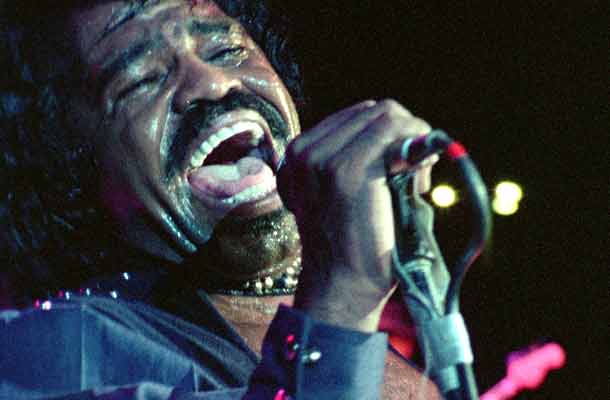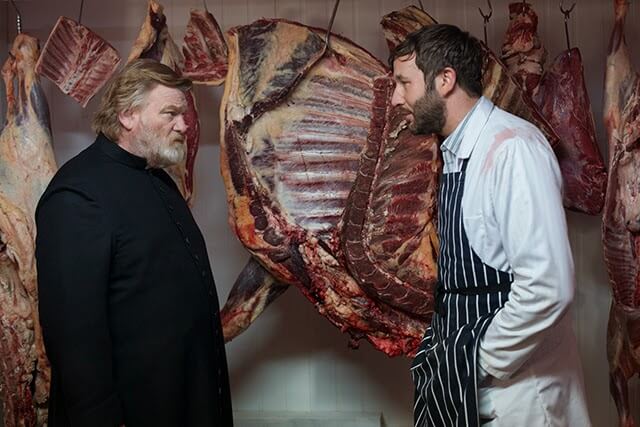In Which Get On Up Can’t Fight the Biopic Convention


The scenes themselves are sometimes, even often, pedestrian: lots of non-illuminating hyping up of “funk” and “groove,” which remain nebulous ideas beyond Brown’s questionable interview assertion (imitated by the movie’s marketing) that every musical act after James Brown has been influenced by him. These kinds of unsupported statements are musical-biopic oxygen: it needs to pump through them constantly, or start gasping for life. But their juxtaposition, along with occasional fourth-wall-breaking in Chadwick Boseman’s electric impersonation, breaks the movie out of the staid genre rhythms and imitates its subject’s unflagging energy.
Until, that is, it tires itself out.
Presumably bowing to the demands of the Ray/Walk the Line template and their middlebrow awards temptations, Get On Up eventually settles into linearity, starting with Brown’s teenage stint in jail for stealing a three-piece suit, continuing with his bunking with Bobby Byrd (Nelsan Ellis) and joining Byrd’s band to form the Famous Flames, who quickly and against their will become James Brown’s backing band; rise to the top; commitment to innovation; tumultuous times; et cetera, et cetera. The cuts out of the normal timeline become more occasional, more like traditional flashbacks; the movie runs long enough that the exciting opening section winds up feeling more like a smart idea refashioned as an extended intro. Late in the movie, Taylor appears to return to a more kaleidoscopic view, as one of Brown’s seventies performances, an exercise in heavy funk, is intercut with a contrasting number from his earlier, pompadoured years—until, halfway through the number, Taylor abandons the idea and lets the seventies performance play out on its own. For all of Boseman’s on-screen brashness, the movie he’s in feels like an ongoing crisis of confidence. Of course, movies are not shot in sequence nor (always) structured on the fly, which makes the movie’s simulation of mid-stream cold feet all the more remarkable.
Get On Up remains watchable, largely because of the fascinating details of Brown’s life and Boseman’s performance. The movie tries to shape Boseman’s relationship with Ellis’s Byrd into its narrative arc, but it’s a tough job when Boseman shares just as many scenes with Dan Aykroyd, discussing Brown’s business plan. It’s particularly fascinating to watch the movie grasp around for redemption as Brown’s mercenary instincts take hold and he leaves various people—friends, bandmates, family—in the dust. Brown’s driving philosophy, rooted in poverty and mistrust of his abusive and neglectful birth parents, seems positively Randian. If the movie downplays Brown’s own abusiveness (one episode of domestic violence happens, and offscreen), it makes his terrible behavior clear, and Boseman shows the way a performer can dress up arrogance with showmanship, especially when he has the musical skills to back it up. For most of the movie, he looks very little like Brown (only his old-age makeup bears any resemblance to Brown’s broader, less traditionally handsome face), but his raspy voice and dance moves sell it. Like Eastwood’s Jersey Boys, the movie has a sense of real intimacy when its actor turns and faces the camera. But for most of the 140 minutes, Boseman has to wriggle around in the biopic confines.


This sets up a countdown, complete with onscreen titles alerting us as each new day begins, but Calvary plays with the accompanying expectations. It has the structure of a who-will-do-it, but Father James doesn’t seem interested in an investigation (he has an idea of who might be his would-be killer, though he doesn’t share it with the audience); it also has the framework of one of those English comedies about a town full of lovable eccentrics. Instead, the townspeople are kind of unpleasant (though none of them seem quite like potential murderers), though often funny. McDonagh’s static frames break a lot of conversations into one-shots, emphasizing Gleeson’s stillness and separating him from his sorta-flock. Gleeson anchors the film with decency that never turns holier than thou or hypocritical—another subversion of what we expect from Catholic priests on film.
If McDonagh’s first movie, The Guard, played like one of his brother’s with a slightly lighter (if no less violent) touch, Calvary swings back the other way; it’s a more somber picture than anything by either McDonagh brother so far. It still has plenty of humor, sometimes imitating Martin’s meta-wit (Gleeson calls another character’s pithy wisecrack “one of those lines that sounds witty but doesn’t actually make much sense”). But it’s the most thoughtful religious-themed movies I’ve seen in ages. Get On Up is positioning itself as a summer movie for adults by default: it’s not about superheroes, it doesn’t have lots of visible special effects, and it tries to move you, even though it’s not really sure how. Calvary actually treats its audience like thinking adults.
You might also like 




















